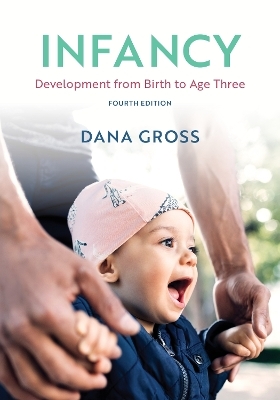
Infancy
Rowman & Littlefield (Verlag)
978-1-5381-6726-7 (ISBN)
The Fourth Edition of Infancy is a comprehensive and accessible core text for courses in infant development and early childhood development. Dana Gross’s sensitive and engaging teaching voice seamlessly weaves together research and theory with current issues of diversity and culture. This latest edition provides students with enough detail to understand methodological issues, explore both practically and theoretically important topics, and engage in thinking critically about development from birth to age three.
Dana Gross is professor of psychology at St. Olaf College, where she teaches infant development and developmental psychology. She has been a faculty member at St. Olaf since 1988. In teaching, research, and scholarship, she emphasizes the interplay of nature and nurture, cross-cultural variations in beliefs and practices, practical applications of research findings, ethical community engagement, and policy considerations. She has developed short-term study abroad courses in India, China, and Norway, as well as student assignments to promote global learning in her on-campus courses.
Preface
Chapter 1: Beliefs about Babies: Historical Perspectives on Children and Childhood
Chapter Overview
Learning Objectives
Why Do We Study Infants?
Development as Transformation
Impact of Early Experience
Research Methods and Tools
Interdisciplinary Collaboration
Recurring Themes in the Study of Child Development
The Path of Development: Stages versus Continuous Change
Heredity and the Environment
Active or Passive Development?
Typical and Atypical Development
Culture and Context in Historical Perspective
Historical Perspectives on Infancy and Early Childhood
Historical Studies of Children and Childhood
Views of Children
Family Life
The Development of the Field of Child Development
Child Development Research, Theory, and Practice
G. Stanley Hall
Maria Montessori
John Watson
Arnold Gesell
Anna Freud
Margaret Mahler
Myrtle McGraw
John Bowlby and Mary Ainsworth
Child Development Organizations
Conclusion
Wrapping It Up
Think About It: Questions for Reading and Discussion
Key Words
Chapter 2: Research Methods
Chapter Overview
Learning Objectives
Issues in Research with Infants
Ethical Concerns
Behavioral State
Inference and Interpretation
Research Settings
Naturalistic Studies
Laboratory Studies
Research Designs
Case Studies and Single-Subject Research
Quasi-Experimental Studies
Experimental Studies
Research Designs for Studying Development
Longitudinal Research
Cross-Sectional Research
Microgenetic Research
Research Measures
Psychophysiological Responses
Behavioral Measures
Parental Reports
Wrapping It Up : Summary and Conclusion
Think About It: Questions for Reading and Discussion
Key Words
Chapter 3: Genetics, Conception, and Prenatal Development
Chapter Overview
Learning Objectives
Genetics and the Human Genome
Genetic Diseases and Disorders
Genetics and Prenatal Development
Conception
Sex Chromosome Abnormalities
Twins and Other Multiples
Infertility and Assisted Reproduction
Prenatal Development
The Germinal Stage, Fertilization to Two Weeks
The Embryonic Stage, Two to Eight Weeks
The Fetal Stage, Eight Weeks to Birth (38 Weeks)
Congenital Anomalies
Neural Tube Defects
Congenital Heart Defects
Prenatal Screening, Diagnosis, and Treatment
Preimplantation Genetic Diagnosis (PGD)
Ultrasound
Maternal Blood Screening
Chorionic Villus Sampling (CVS)
Amniocentesis
Fetal Echocardiography
Fetal Therapy
Prenatal Influences
Nutrition
Alcohol and Drugs
Disease
Stress
Environmental Hazards
Paternal Influences
Wrapping It Up: Summary and Conclusion
Think About It: Questions for Reading and Discussion
Key Words
Chapter 4: Birth and the Newborn
Chapter Overview
Learning Objectives
The Birth Process: Stages of Childbirth
The First Stage: Contractions, Dilatation, and Effacement
The Second Stage: Delivery of the Infant
The Third Stage: Placental Expulsion
Complications of Childbirth
Failure to Progress
Breech Presentation
Preterm Birth
Low Birthweight
Post-Term Birth
Twins and Other Multiple Births
Childbirth Options
Medical Interventions
Hospital or Home?
Neonatal Assessment
Assessment at Birth
Reflexes
Sensory Abilities
Adaptations during the Neonatal Period
Wrapping It Up: Summary and Conclusion
Think About It: Questions for Reading and Discussion
Key Words
Chapter 5: Physical Growth, Health, and Nutrition
Chapter Overview
Learning Objectives
Physical Growth
Measuring and Predicting Growth
Failure to Thrive
Brain Development
Maltreatment and the Brain
Health and Safety
Newborn Screening
Screening for Lead Poisoning
Infant Mortality
Common Illnesses and Immunizations
Accidental Injuries
Sudden Unexplained Infant Death
Nutrition and Feeding
Nutritional Requirements in Infancy
Breast Milk
Nutritional Requirements in Toddlerhood
The Problem of Malnutrition
Wrapping It Up: Summary and Conclusion
Think About It: Questions for Reading and Discussion
Key Words
Chapter 6: Sensation, Perception, and Motor Development
Chapter Overview
Learning Objectives
Theories of Infant Perception
Vision
Newborn Abilities
Perceiving Objects
Perceiving Depth
Perceiving Images on Screens
Hearing
Locating Sounds
Perceiving Speech
Listening to Music
Music Perception
Touch
Reflexes
Pain
Taste
Innate Preferences
Effects of Experience
Smell
Innate Preferences
Effects of Experience
Other Senses, Intermodal and Cross-Modal Perception
Other Senses
Intermodal Abilities
Cross-Modal Abilities
Motor Development
Assessing Motor Development
Fine Motor Skills: Reaching, Grasping, and Using Tools
Gross Motor Skills: Sitting, Crawling, and Walking
The Cultural Context
Wrapping It Up: Summary and Conclusion
Think About It: Questions for Reading and Discussion
Key Words
Chapter 7: Play and Foundational Theories about Cognitive Development
Chapter Overview
Learning Objectives
The Development of Play
Play with Objects
Social Play
Pretend/Symbolic Play
Piaget’s Theory: Constructing and Representing Knowledge
Sensorimotor and Preoperational Intelligence
Object Permanence
The A-Not-B Error
Understanding and Using Representations of Space
Vygotsky’s Sociocultural Theory: Learning as A Social Activity
The Zone of Proximal Development
Guided Participation
Wrapping It Up: Summary and Conclusion
Think About It: Questions for Reading and Discussion
Key Words
Chapter 8: Cognitive Science and Intelligence
Chapter Overview
Learning Objectives
Cognitive Science Perspectives
Attention
Gaze Following, Joint Attention, and Theory of Mind
Memory
Categorization
Defining and Testing Intelligence in Infancy
Traditional Tests
Information-Processing Assessments
Wrapping It Up: Summary and Conclusion
Think About It: Questions for Reading and Discussion
Key Words
Chapter 9: Language and Communication
Chapter Overview
Learning Objectives
Studying Language Development
Why Language Matters
Systems of Language
Theoretical Foundations
Prelinguistic Communication
Receptivity to Language
Speech Perception
Early Production: Babbling
Gestural Communication
Semantic Development
Milestones in the Acquisition of Meaning
One-Word Utterances
Individual Differences in Language Experience
Explaining Early Word Learning
The Acquisition of Grammar
Multiword Utterances
Overregularization
Cross-Linguistic Studies of the Acquisition of Grammar
Atypical Language Development
Measuring Language Development
Early Language Delay and Specific Language Impairment
Language and Communication in Children with Autism Spectrum Disorder
Wrapping It Up: Summary and Conclusion
Think About It: Questions for Reading and Discussion
Key Words
Chapter 10: Relationships and Social Development
Chapter Overview
Learning Objectives
Infant–Caregiver Relationships
Patterns of Care and Interaction: Beliefs about Infants
Cross-Cultural Differences in Mothers’ Involvement
Father–Infant Caregiving and Interaction
Cross-Cultural Differences in Fathers’ Involvement
Postpartum Depression
The Influence of Culture and Context
How Postpartum Depression Affects Infants
Intervention Approaches
Developing Trust, Becoming Attached
Bowlby’s Theory of Infant–Caregiver Attachment
Assessing Attachment Relationships
Attachment and Subsequent Development
Sibling Relationships
Becoming a Sibling
How Siblings Contribute to Development
Peer Relationships and Friendship
Peer Interactions
Friendship
Wrapping It Up: Summary and Conclusion
Think About It: Questions for Reading and Discussion
Key Words
Chapter 11: Temperament, Emotions, and the Self
Chapter Overview
Learning Objectives
Temperament
Defining and Measuring Temperament
Temperament and Biology
Temperament and Attachment
Temperament and Personality
Emotions
Theories of Emotion
Expressing Emotions
Perceiving Emotions
Parent Influences on Emotion Development
Regulating Emotions
Developing and Using Social Emotions
The Self
Recognizing the Self
Wrapping It Up: Summary and Conclusion
Think About It: Questions for Reading and Discussion
Key Words
Chapter 12: Childcare and Early Intervention
Chapter Overview
Learning Objectives
Childcare
Maternal Employment
Parental Leave Policies
Childcare Arrangements
Effects of Childcare: The NICHD Study of Early Child Care and Youth Development
Including Children with Disabilities in Childcare
Early Intervention
Poverty as a Risk Factor: Implications for Prevention and Intervention
Early Intervention through Childcare and Preschool
Early Head Start
Measuring the Impact of Early Childhood Intervention
Wrapping It Up: Summary and Conclusion
Think About It: Questions for Reading and Discussion
Key Words
Glossary
References
Index
About the Author
| Erscheinungsdatum | 12.07.2023 |
|---|---|
| Verlagsort | Lanham, MD |
| Sprache | englisch |
| Maße | 217 x 272 mm |
| Gewicht | 1139 g |
| Themenwelt | Geisteswissenschaften ► Psychologie ► Entwicklungspsychologie |
| Sozialwissenschaften ► Pädagogik ► Vorschulpädagogik | |
| Sozialwissenschaften ► Soziologie | |
| ISBN-10 | 1-5381-6726-3 / 1538167263 |
| ISBN-13 | 978-1-5381-6726-7 / 9781538167267 |
| Zustand | Neuware |
| Informationen gemäß Produktsicherheitsverordnung (GPSR) | |
| Haben Sie eine Frage zum Produkt? |
aus dem Bereich


